Lyons W.C. (ed.). Standard handbook of petroleum and natural gas engineering.2001- Volume 1
Подождите немного. Документ загружается.

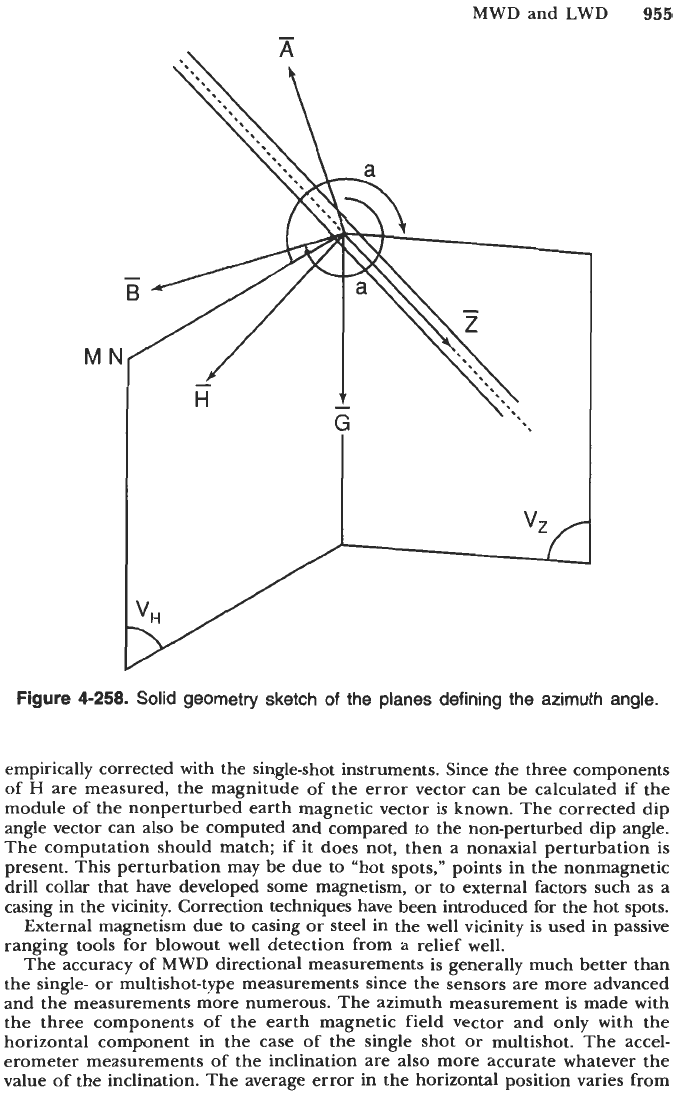
MWD and LWD
955
M
J
-
H
Figure
4-258.
Solid geometry sketch
of
the planes defining the azimuth angle.
empirically corrected with the single-shot instruments. Since the three components
of
H
are measured, the magnitude
of
the error vector can be calculated if the
module
of
the nonperturbed earth magnetic vector is known. The corrected dip
angle vector can also be computed and compared to the non-perturbed dip angle.
The computation should match; if it does not, then a nonaxial perturbation is
present. This perturbation may be due to “hot spots,” points in the nonmagnetic
drill collar that have developed some magnetism, or to external factors such as a
casing in the vicinity. Correction techniques have been introduced for the hot spots.
External magnetism due to casing or steel in the well vicinity is used in passive
ranging tools
for
blowout well detection from a relief well.
The accuracy
of
MWD directional measurements
is
generally much better than
the single- or multishot-type measurements since the sensors are more advanced
and the measurements more numerous. The azimuth measurement is made with
the three components
of
the earth magnetic field vector and only with the
horizontal component in the case of the single shot or multishot. The accel-
erometer measurements of the inclination are also more accurate whatever the
value
of
the inclination. The average error in the horizontal position varies from
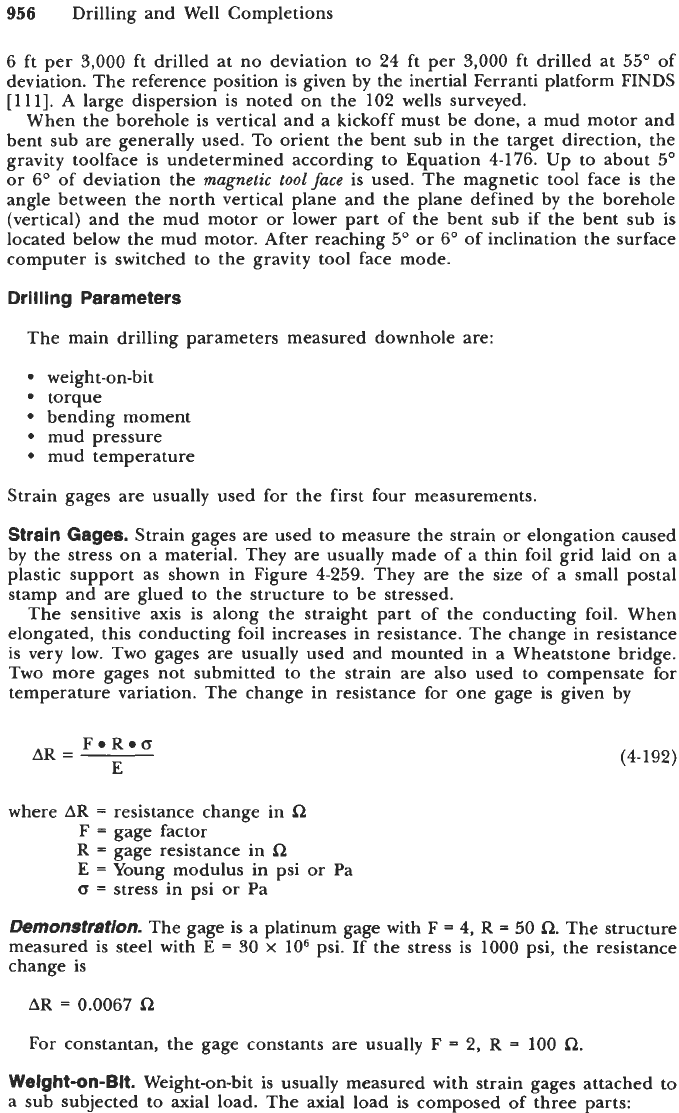
956
Drilling and Well Completions
6
ft per 3,000 ft drilled at no deviation to 24
ft
per
3,000
ft
drilled at 55" of
deviation. The reference position is given by the inertial Ferranti platform FINDS
[lll].
A
large dispersion is noted on the 102 wells surveyed.
When the borehole is vertical and a kickoff must be done, a mud motor and
bent sub are generally used. To orient the bent sub in the target direction, the
gravity toolface is undetermined according to Equation 4-176. Up to about 5"
or
6"
of deviation the
magnetic
tool
face
is used. The magnetic tool face is the
angle between the north vertical plane and the plane defined by the borehole
(vertical) and the mud motor or lower part of the bent sub
if
the bent sub is
located below the mud motor. After reaching 5" or
6"
of inclination the surface
computer is switched to the gravity tool face mode.
Drilling Parameters
The main drilling parameters measured downhole are:
weight-on-bit
torque
bending moment
mud pressure
mud temperature
Strain gages are usually used for the first four measurements.
Strain Gages.
Strain gages are used to measure the strain or elongation caused
by the stress on a material. They are usually made of a thin foil grid laid on a
plastic support as shown in Figure 4-259. They are the size of a small postal
stamp and are glued to the structure to be stressed.
The sensitive axis is along the straight part of the conducting foil. When
elongated, this conducting foil increases in resistance. The change in resistance
is very low. Two gages are usually used and mounted in a Wheatstone bridge.
Two more gages not submitted to the strain are also used to compensate for
temperature variation. The change in resistance for one gage is given by
F*R.o
E
AR
=
(4-192)
where
AR
=
resistance change in
R
F
=
gage factor
R
=
gage resistance in
R
E
=
Young modulus in psi or Pa
o
=
stress in psi or Pa
Demonstfation.
The gage is a platinum gage with F
=
4,
R
=
50
a.
The structure
measured is steel with
E
=
30
x
lo6
psi. If the stress is 1000 psi, the resistance
change is
AR
=
0.0067
R
For constantan, the gage constants are usually
F
=
2,
R
=
100
R.
Weightsn-Bit.
Weight-on-bit is usually measured with strain gages attached to
a sub subjected to axial load. The axial load is composed
of
three parts:
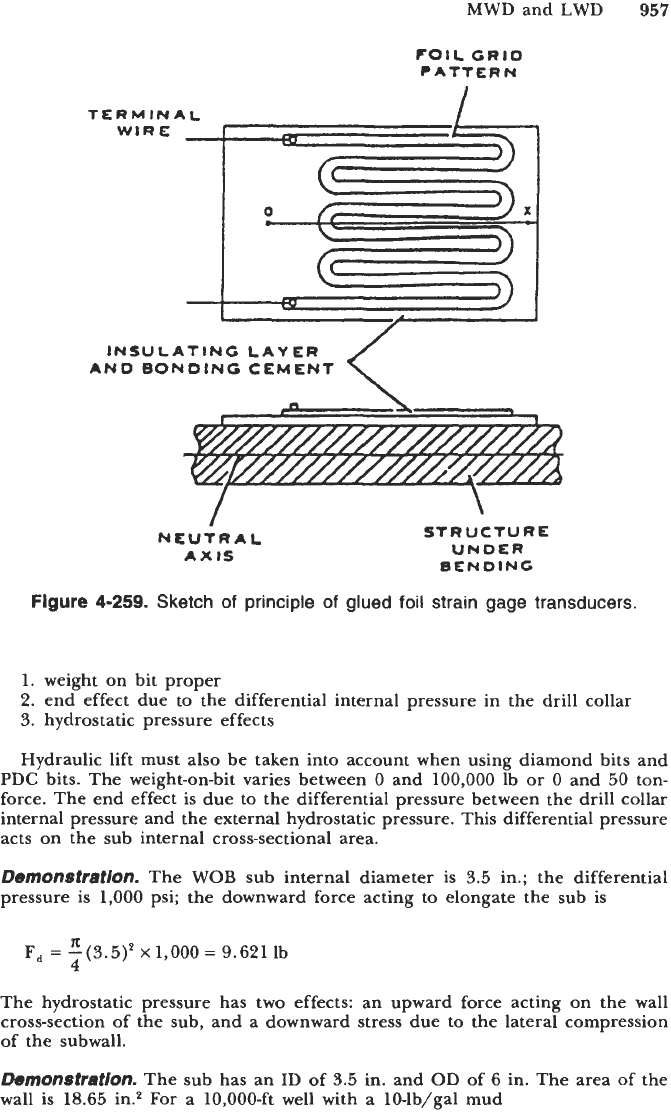
MWD and LWD
957
FOIL
GRID
PATTERN
TERMINAL
WIRE
I
0
*
fr
<
INSULATING LAYER
AND
BONDING
CEMENT
I
NEUTRAL
AXIS
STRUCTURE
UNDER
BENDING
Figure
4-259.
Sketch
of
principle
of
glued
foil
strain gage transducers.
1. weight on bit proper
2.
end effect due to the differential internal pressure in the drill collar
3. hydrostatic pressure effects
Hydraulic lift must also be taken into account when using diamond bits and
PDC bits. The weight-on-bit varies between
0
and 100,000 lb or
0
and
50
ton-
force. The end effect is due to the differential pressure between the drill collar
internal pressure and the external hydrostatic pressure. This differential pressure
acts on the sub internal cross-sectional area.
Demonstration.
The
WOB
sub internal diameter is 3.5 in.; the differential
pressure
is
1,000 psi; the downward force acting to elongate the sub is
R
F,
=
-(3.5)*
x
1,000
=
9.621
lb
4
The hydrostatic pressure has two effects: an upward force acting on the wall
cross-section of the sub, and a downward stress due to the lateral compression
of the subwall.
Demon8tratioff.
The sub has an ID of 3.5 in. and OD of
6
in. The area of the
wall is 18.65 in.* For a 10,000-ft well with a 10-lb/gal mud

958
Drilling and Well Completions
P,
=
0.052
x
10,000
x
10
=
5,200
psi
The upward force acting on the sub is
F,
=
96,980 lb
The downward stress due to the mud pressure (neglecting the differential
pressure) is
<T
=
2
x
v
x
P,
(4-193)
where
=
stress downward (trying to elongate the sub)
v
=
Poisson ratio of the sub
P,
=
hydrostatic pressure
Demonstration.
For steel,
v
=
0.3 and
P,
=
5,200
psi and
o
=
2
x
0.3
x
5,200
=
3,120 psi.
This stress is to be accounted for when computing the total stress in the sub
wall. The calculation can be done easily in real time with a computer; however,
it is easier and probably more accurate to measure a difference in strain (or
stress) in the sub between the off-bottom position and while drilling. This value
should be related closely to the true weight-on-bit.
Torque.
The torque
is
measured by placing two strain gages at 45" on the sub
as shown in Figure 4-260. Stress at 45" due to torque is
T
R,
n(R2
-
Rf)
<T=
where
=
stress in psi
Ro
=
outer radius in in.
Ri
=
inner radius in
in.
T
=
torque in in. lb
Strain is
T
R,
E=*-x
G
rc(RZ-RY)
where
G
is shear modulus (usually 12
x
lo6
psi) and
Ro
xFxR
T
G
n(Rt
-Rt)
AR=~-x
Demonstration.
Platinum gages on steel collar:
T
=
2,000
ft
.
lb
Ro
=
2.5 in.
F=2
R
=
100
R
(4-194)
(4- 195)
(4-1 96)
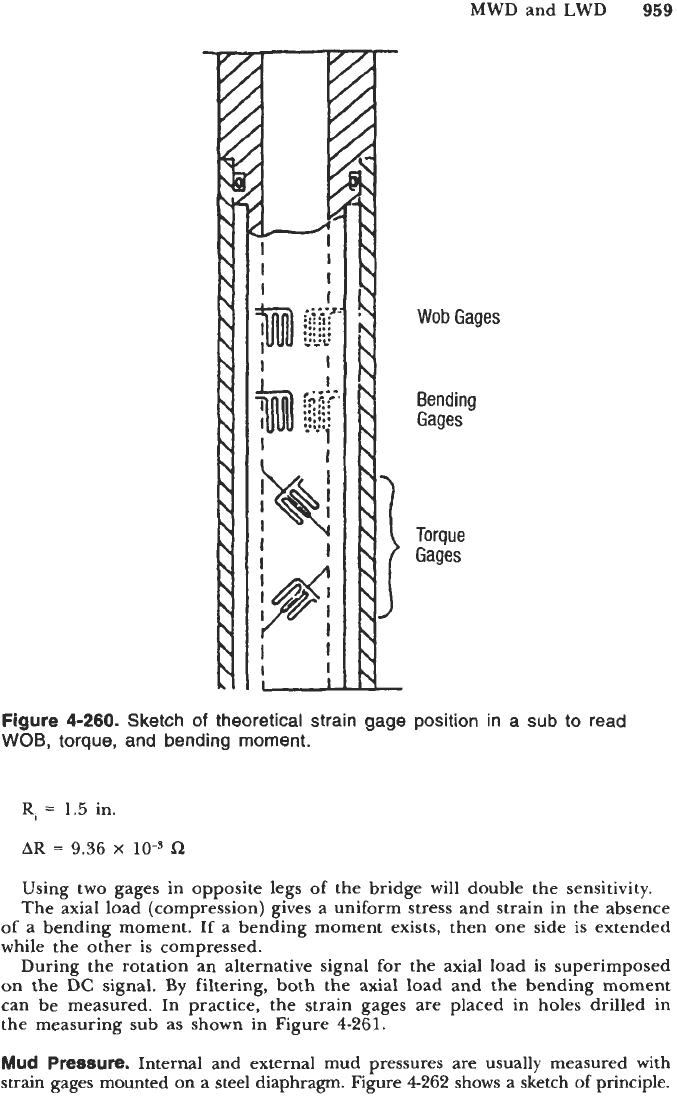
MWD
and
LWD
959
I
I
I
f
I
I
I
p
*:::!i
*...e.
'...L.
.-
I
I
I
'-":*i
I
I
I
I
I
I
I
u
I
Wob
Gages
Bending
Gages
Torque
Gages
Figure
4-260.
Sketch
of
theoretical strain gage position in a
sub
to read
WOB,
torque, and bending moment.
R,
=
1.5
in.
AR
=
9.36
X
R
Using two gages in opposite legs
of
the bridge will double the sensitivity.
The axial load (compression) gives a uniform stress and strain in the absence
of
a bending moment.
If
a bending moment exists, then one side is extended
while the other is compressed.
During the rotation an alternative signal for the axial load is superimposed
on the DC signal. By filtering, both the axial load and the bending moment
can be measured. In practice, the strain gages are placed in holes drilled in
the measuring sub as shown in Figure
4-261.
Mud Pressure.
Internal and external mud pressures are usually measured with
strain gages mounted on a steel diaphragm. Figure
4262
shows a sketch
of
principle.
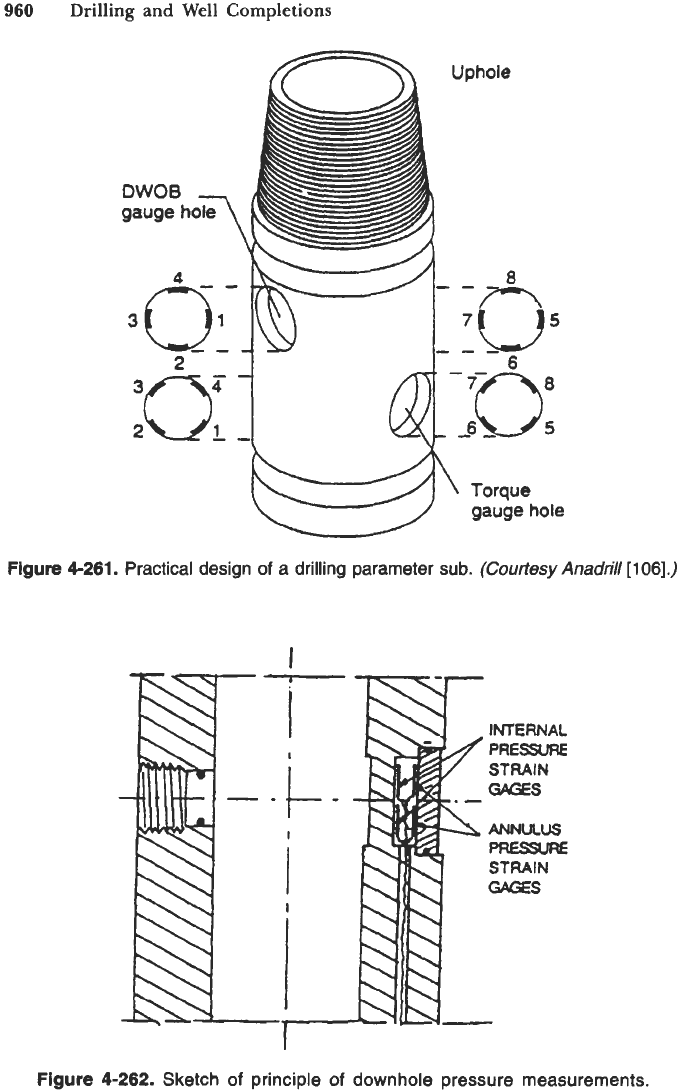
960
Drilling and Well Completions
Figure 4-261.
Practical design
of
a drilling parameter
sub.
(Courtesy
Anadrill
[106].)
I
Figure 4-262.
Sketch
of
principle
of
downhole pressure measurements.
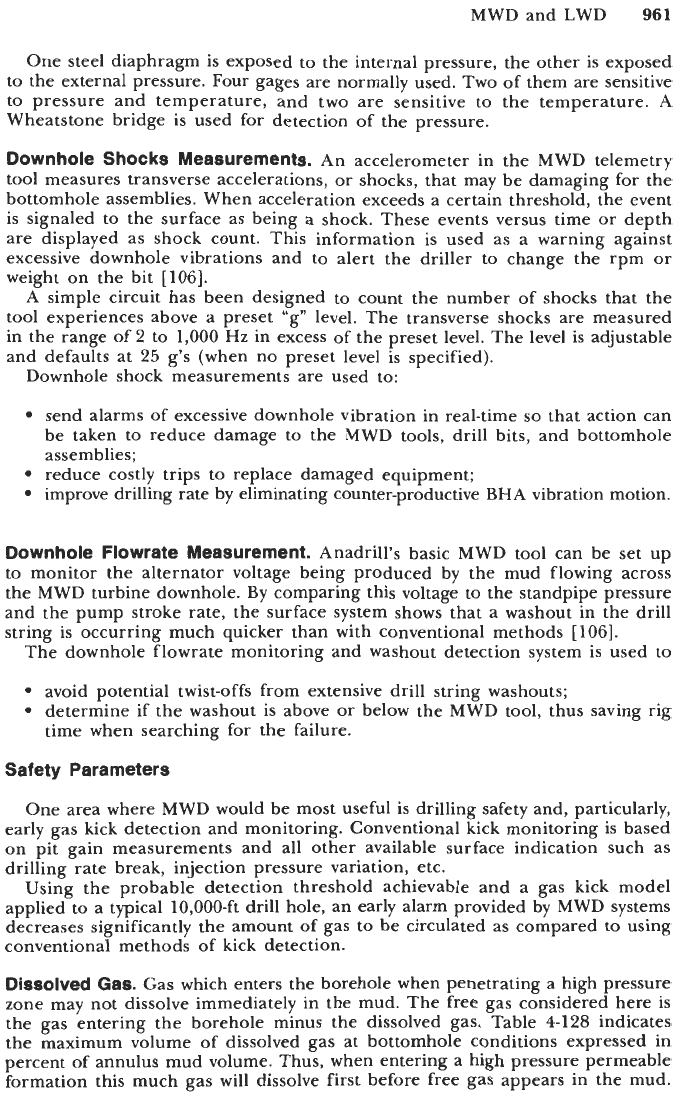
MWD and LWD
961
One steel diaphragm is exposed to the internal pressure, the other is exposed
to the external pressure. Four gages are normally used. Two of them are sensitive
to pressure and temperature, and two are sensitive to the temperature.
A
Wheatstone bridge is used for detection of the pressure.
Downhole Shocks Measurements.
An accelerometer in the MWD telemetry
tool measures transverse accelerations, or shocks, that may be damaging for the
bottomhole assemblies. When acceleration exceeds a certain threshold, the event
is signaled to the surface as being a shock. These events versus time or depth
are displayed as shock count. This information is used as a warning against
excessive downhole vibrations and to alert the driller to change the rpm or
weight on the bit
[106].
A simple circuit has been designed to count the number of shocks that the
tool experiences above a preset “g” level. The transverse shocks are measured
in the range of
2
to
1,000
Hz
in excess of the preset level. The level
is
adjustable
and defaults at
25
g’s (when no preset level is specified).
Downhole shock measurements are used to:
send alarms of excessive downhole vibration in real-time
so
that action can
be taken to reduce damage to the MWD tools, drill bits, and bottomhole
assemblies;
reduce costly trips to replace damaged equipment;
improve drilling rate by eliminating counter-productive BHA vibration motion.
Downhole Flowrate Measurement.
Anadrill’s basic MWD tool can be set up
to monitor the alternator voltage being produced by the mud flowing across
the MWD turbine downhole.
By
comparing this voltage to the standpipe pressure
and the pump stroke rate, the surface system shows that a washout in the drill
string is occurring much quicker than with conventional methods
[106].
The downhole flowrate monitoring and washout detection system is used to
avoid potential twist-offs from extensive drill string washouts;
determine if the washout is above or below the MWD tool, thus saving rig
time when searching for the failure.
Safety Parameters
One area where MWD would be most useful is drilling safety and, particularly,
early gas kick detection and monitoring. Conventional kick monitoring is based
on pit gain measurements and all other available surface indication such as
drilling rate break, injection pressure variation, etc.
Using the probable detection threshold achievable and a gas kick model
applied to a typical 10,000-ft drill hole, an early alarm provided by MWD systems
decreases significantly the amount of gas to be circulated as compared to using
conventional methods of kick detection.
Dissolved Gas.
Gas which enters the borehole when penetrating a high pressure
zone may not dissolve immediately in the mud. The free gas considered here is
the gas entering the borehole minus the dissolved gas. Table
4-128
indicates
the maximum volume of dissolved gas at bottomhole conditions expressed in
percent of annulus mud volume. Thus, when entering a high pressure permeable
formation this much gas will dissolve first before free gas appears in the mud.
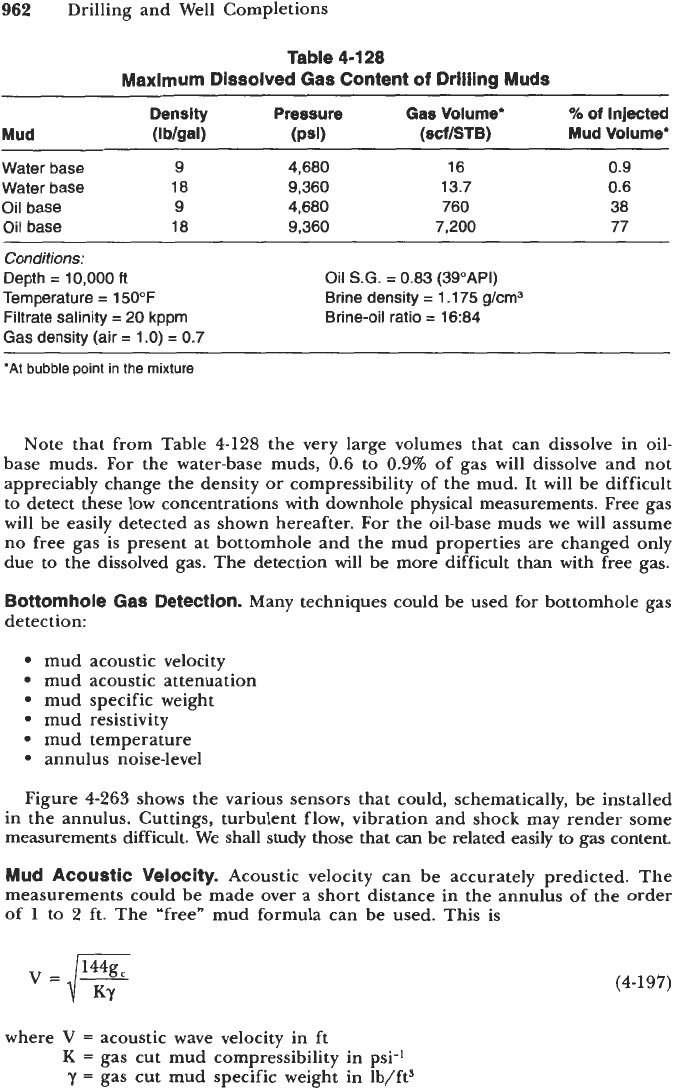
962
Drilling and Well Completions
Table
4-1
28
Maximum Dissolved Gas Content
of
Drilling Muds
Density Pressure
Gas
Volume’
%
of
InJected
Mud
(Iblgal)
(PSI)
(scflSTB)
Mud Volume*
Water base
9 4,680
16 0.9
Water base
18
9,360
13.7 0.6
Oil base
9 4,680 760 38
Oil base
18
9,360 7,200 77
Conditions:
Depth
=
10,000
ff
Temperature
=
150°F
Filtrate salinity
=
20
kppm
Gas density (air
=
1
.O)
=
0.7
Oil
S.G.
=
0.83 (39”API)
Brine density
=
1
.I
75
g/cm3
Brine-oil ratio
=
16234
“At
bubble
point
in
the
mixture
Note that from Table
4-128
the very large volumes that can dissolve in oil-
base muds. For the water-base muds,
0.6
to
0.9%
of gas will dissolve and not
appreciably change the density or compressibility of the mud. It will be difficult
to detect these low concentrations with downhole physical measurements. Free gas
will be easily detected as shown hereafter. For the oil-base muds we will assume
no free gas is present at bottomhole and the mud properties are changed only
due to the dissolved gas. The detection will be more difficult than with free gas.
Bottomhole Gas Detection.
Many techniques could be used for bottomhole gas
detection:
mud acoustic velocity
mud acoustic attenuation
mud specific weight
mud resistivity
mud temperature
annulus noise-level
Figure
4-263
shows the various sensors that could, schematically, be installed
in the annulus. Cuttings, turbulent flow, vibration and shock may render some
measurements difficult. We shall study those that can be related easily to gas content.
Mud Acoustic Velocity.
Acoustic velocity can be accurately predicted. The
measurements could be made over a short distance in the annulus of the order
of
1
to
2
ft. The “free” mud formula can be used. This is
(4-
197)
where
V
=
acoustic wave velocity in ft
K
=
gas cut mud compressibility in psi-’
y
=
gas cut mud specific weight in lb/ft3
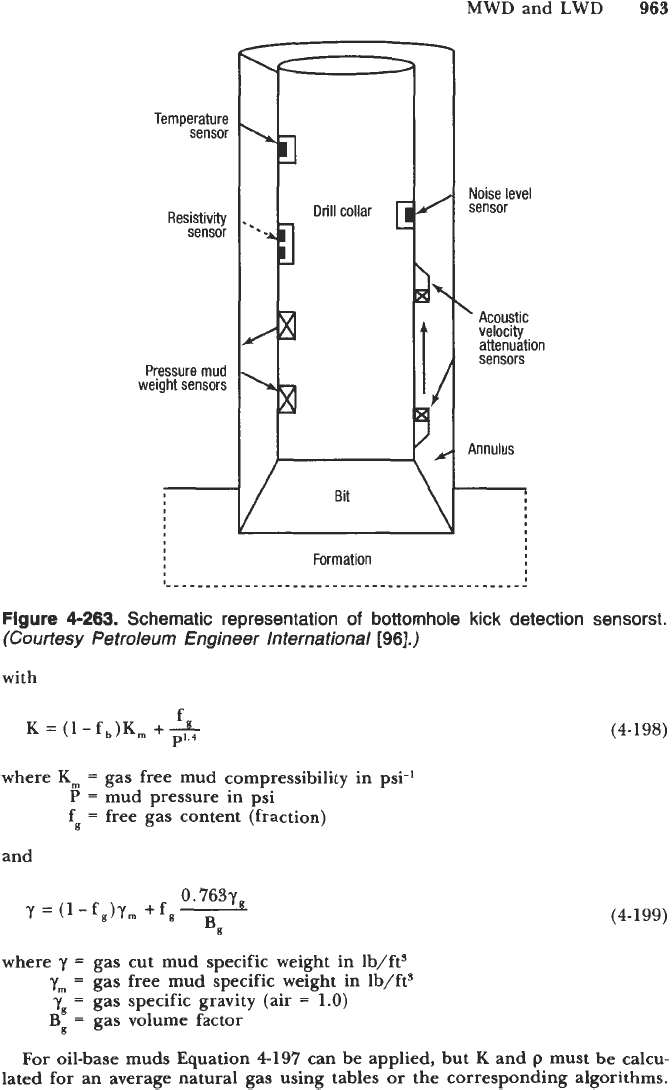
MWD
and
LWD
963
Temperature
sensor
Resistivity
sensor
Pressure
mud
weight sensors
Drill collar
I*
__
Formation
Noise level
sensor
'
Acoustic
velocity
attenuation
sensors
Annulus
Figure
4-263.
Schematic representation
of
bottomhole kick detection sensorst.
(Courtesy Petroleum Engineer International
[96].)
with
where
Km
=
gas free mud compressibility in psi-'
P
=
mud pressure in psi
f,
=
free gas content (fraction)
and
(4-1
98)
(4-1
99)
where
y
=
gas cut mud specific weight in lb/ft3
Y,
=
gas free mud specific weight in lb/ft3
Y,
=
gas specific gravity
(air
=
1.0)
BK
=
gas volume factor
For
oil-base muds Equation
4-197
can be applied, but
K
and
p
must be calcu-
lated for an average natural gas using tables
or
the corresponding algorithms.

964
Drilling and Well Completions
Table 4-128 shows maximum dissolved gas concentrations in drilling muds at
the bottom of the hole. Figure 4-264 shows the variation of the acoustic velocity
for two water-base muds and two oil-base muds of 9 and 18 lb/gal at pressures
of 5,000 and 10,000 psi.
A
sharp velocity decrease is seen for the water-base muds. Assuming a
threshold detection of 500 ft/s, the alarm could be given for
0.5%
of free gas
or 1.1 to 1.4% of total gas (dissolved and free).
The oil-base muds having no free gas behave differently and the 5OO-ft/s
threshold is not reached before approximately 5% of gas is dissolved. Then the
velocity decrease is almost as fast as with the water-base mud.
Mud Specific Weight.
The water-base mud specific weight can be calculated readily
using Equation 4-199. The oil-base mud specific weight requires the use of tables.
The variations are shown in Figure 4-265 for the same 9- and 18-lb/gal muds.
Specific weight-wise, the muds behave in a similar manner. Assuming that a
density measurement with the gradiomanometer can be made accurately, the
specific weight threshold would be 0.15 lb/gal. The gas content of the mud would
be 2 to 5% according mainly to the density, the greater sensitivity being for
the heavier mud.
Mud Resistivity.
The mud resistivity can be measured only with the water-base
muds. It is measured easily with a small microlog-type sensor embedded in the
outer wall of the drill collar. Assuming the free gas is dispersed in small bubbles
in the mud, the resistivity of the gas cut mud is
Gas
In
mud,
YO
of
volume
Figure
4-264.
Acoustic velocity in the annulus
as
a function
of
the gas
content in the
mud.
(Courtesy
Petroleum Engineer lnternational
[96].)
